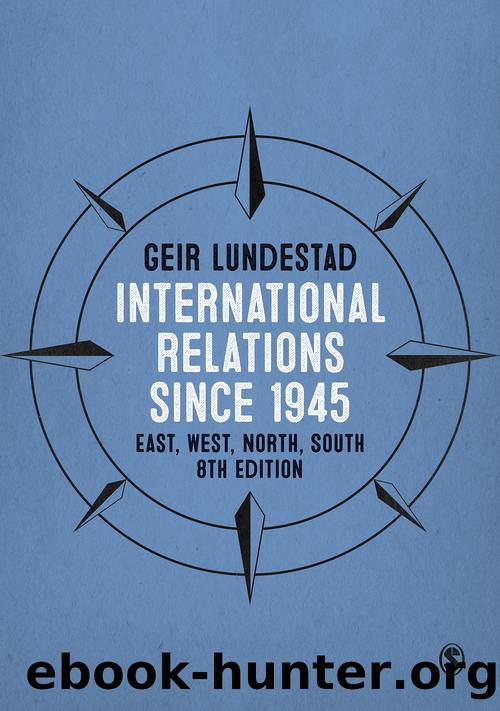East, West, North, South: Major Developments in International Politics Since 1945: Major Developments in International Relations Since 1945 by Geir Lundestad

Author:Geir Lundestad [Lundestad, Geir]
Language: eng
Format: epub
Tags: International Relations, Political Science, History, Politics, General
ISBN: 9781412907484
Google: j4aWAgAAQBAJ
Goodreads: 159181
Publisher: Sage Publications Ltd
Published: 1985-04-23T00:00:00+00:00
European Integration, 1945â1973
The United States wanted to weave the Western European countries into a comprehensive international network. Economically, what was needed in 1945â46 was to attain their support for the World Bank and the International Monetary Fund. In 1947â48, the Marshall Plan was based on close cooperation across the Atlantic, although the United States did not join the organization that administered the assistance, the Organization for European Economic Cooperation (OEEC). The European economies were also to be made more open through the establishment of the International Trade Organization, which never materialized, and through the General Agreement on Tariffs and Trade (GATT). NATO brought the United States and Western Europe closer together militarily and politically.
At the same time, the Americans encouraged much closer cooperation among the countries of Western Europe. Truman, and to an even greater extent the Eisenhower administration, actively supported the Western European efforts at integration. This was evident on a number of occasions. Washington would have preferred the OEEC to become as binding as possible in the form of a permanent customs union, but the OEEC did not go that far. The Americans showed all the more support for the continental countries when they joined together in supranational organizations.
It can roughly be said that there were two main attitudes towards integration in Western Europe during the postwar period, later often called the federalist and confederalist views. The former dominated on the continent and aimed at supranational cooperation within certain sectors, or preferably in general. The latter accepted a certain degree of coordination of policies in the various countries, but without them relinquishing any of their independence and without any sweeping institutionalization. This view dominated in Britain, in the Scandinavian countries, and in Switzerland and Austria.
The federalist way of thinking was behind the Coal and Steel Community (1950), the proposal for a European army (1950â54), Euratom (1958), and the European Economic Community (1958). The confederalist philosophy formed the basis for the OEEC (1948), the European Council (1949), and the European Free Trade Association (EFTA) (1960). Despite these divergent attitudes, historically the extent of cooperation and integration in Western Europe was an important new phenomenon. Several factors must be included to explain this development in the 1940s and 1950s.
On the international level, the influence of the United States and the Soviet Union was important, although in different ways. As mentioned, the United States encouraged the Western Europeans to cooperate, clearly preferring what is here called a federalist approach to a confederalist one. The Soviet contribution was based on the fact that European integration was also a means of containing Soviet and communist influence.
The international standing of the United States and the Soviet Union showed that the traditional European powers had become second- and third-ranking nations. The French and British colonial empires began to disintegrate. Only through European cooperation could Western Europe make its voice heard once more. Later, experiences such as the Suez conflict (see pp. 56â7) would explicitly confirm how reduced the role of Britain and France had become, and especially that of France.
Download
This site does not store any files on its server. We only index and link to content provided by other sites. Please contact the content providers to delete copyright contents if any and email us, we'll remove relevant links or contents immediately.
Adding Value to Policy Analysis and Advice by Claudia Scott; Karen Baehler(482)
Race and American Political Development by unknow(465)
Sociological Perspectives of Health and Illness by Constantinos N. Phellas(462)
American Government and Politics Today by Steffen W. Schmidt Mack C. Shelley Barbara A. Bardes(454)
Human and Global Security : An Exploration of Terms by Peter Stoett(444)
Entrepreneurship Education and Training: The Issue of Effectiveness by Colette Henry Frances Hill Claire Leitch(437)
Control Of Oil - Hardback by Kayal(426)
Materializing the Middle Passage by Jane Webster;(422)
Advances in Child Development and Behavior, Volume 37 by Patricia J. Bauer(381)
The Catholic Church and European State Formation, AD 1000-1500 by Jørgen Møller(374)
The World According to China by Elizabeth C. Economy(360)
Left Is Not Woke by Susan Neiman(345)
Theories of Counseling and Psychotherapy: A Case Approach by Nancy L. Murdock(342)
Turkey's Relations with the West and the Turkic Republics: The Rise and Fall of the Turkish Model by Idris Bal(337)
The Disappearance of Rituals: A Topology of the Present by Byung-Chul Han(333)
Cross-Cultural Child Development for Social Workers by Lena Robinson(330)
Application of classical statistics, logratio transformation and multifractal approaches to delineate geochemical anomalies in the Zarshuran gold district, NW Iran by unknow(322)
Japan's Ainu Minority in Tokyo by Mark K. Watson(315)
Laboratory Life by Bruno Latour(311)
